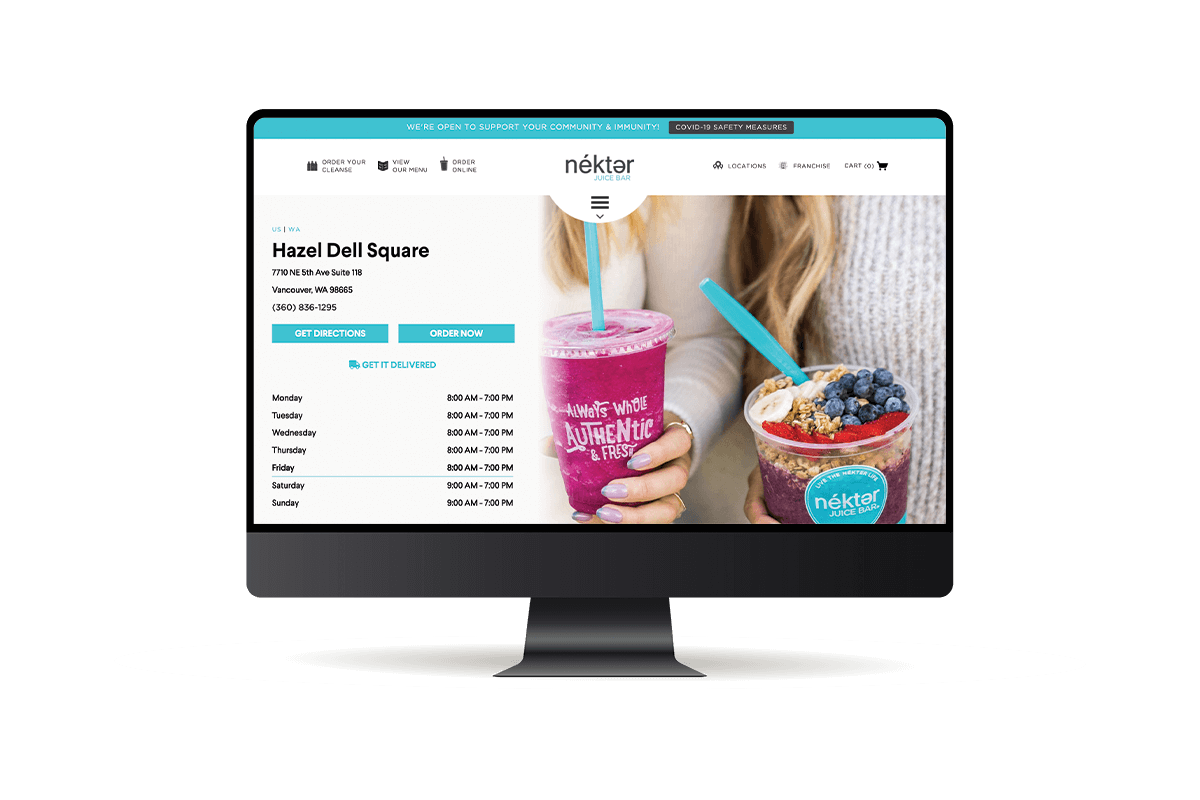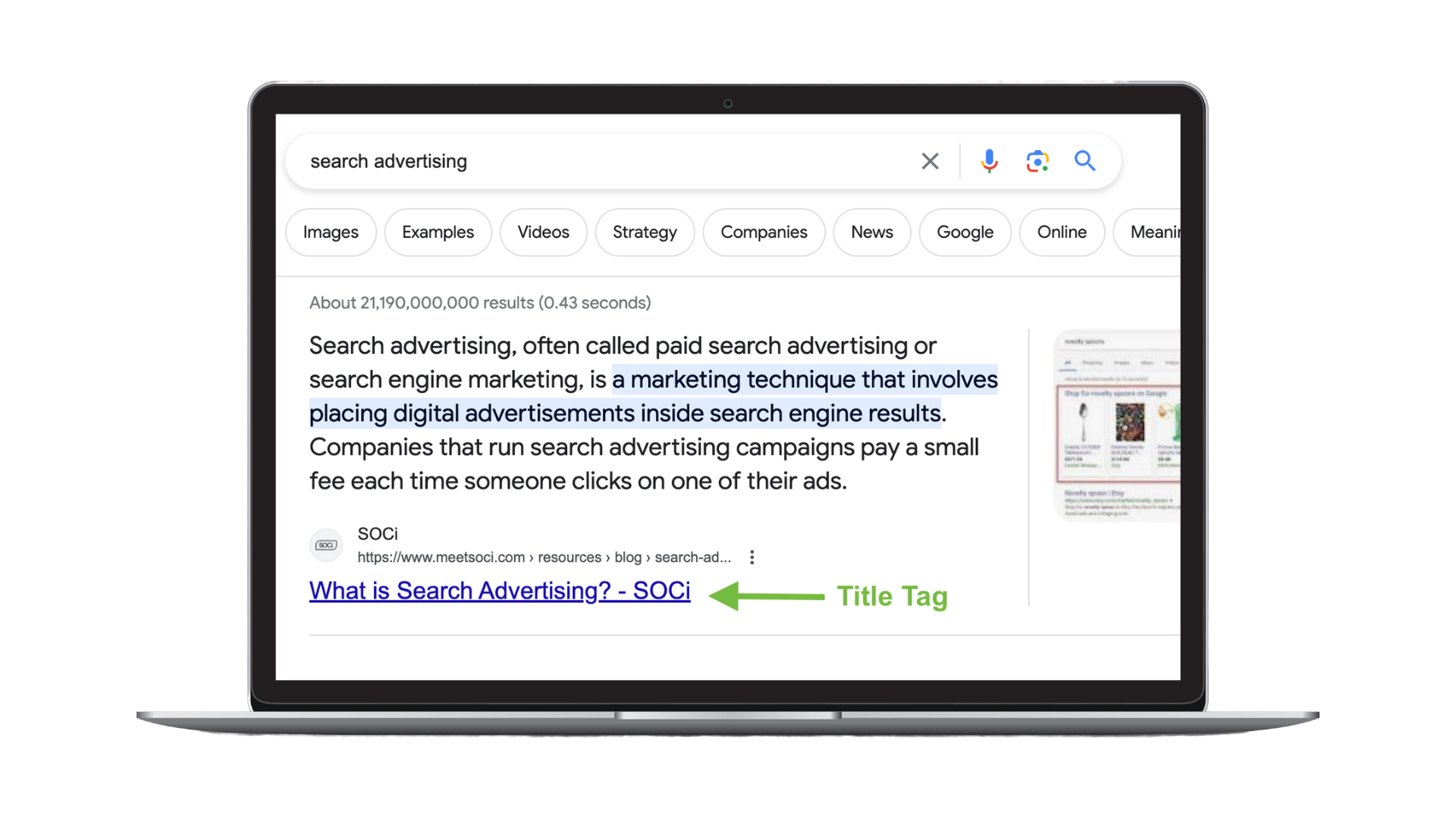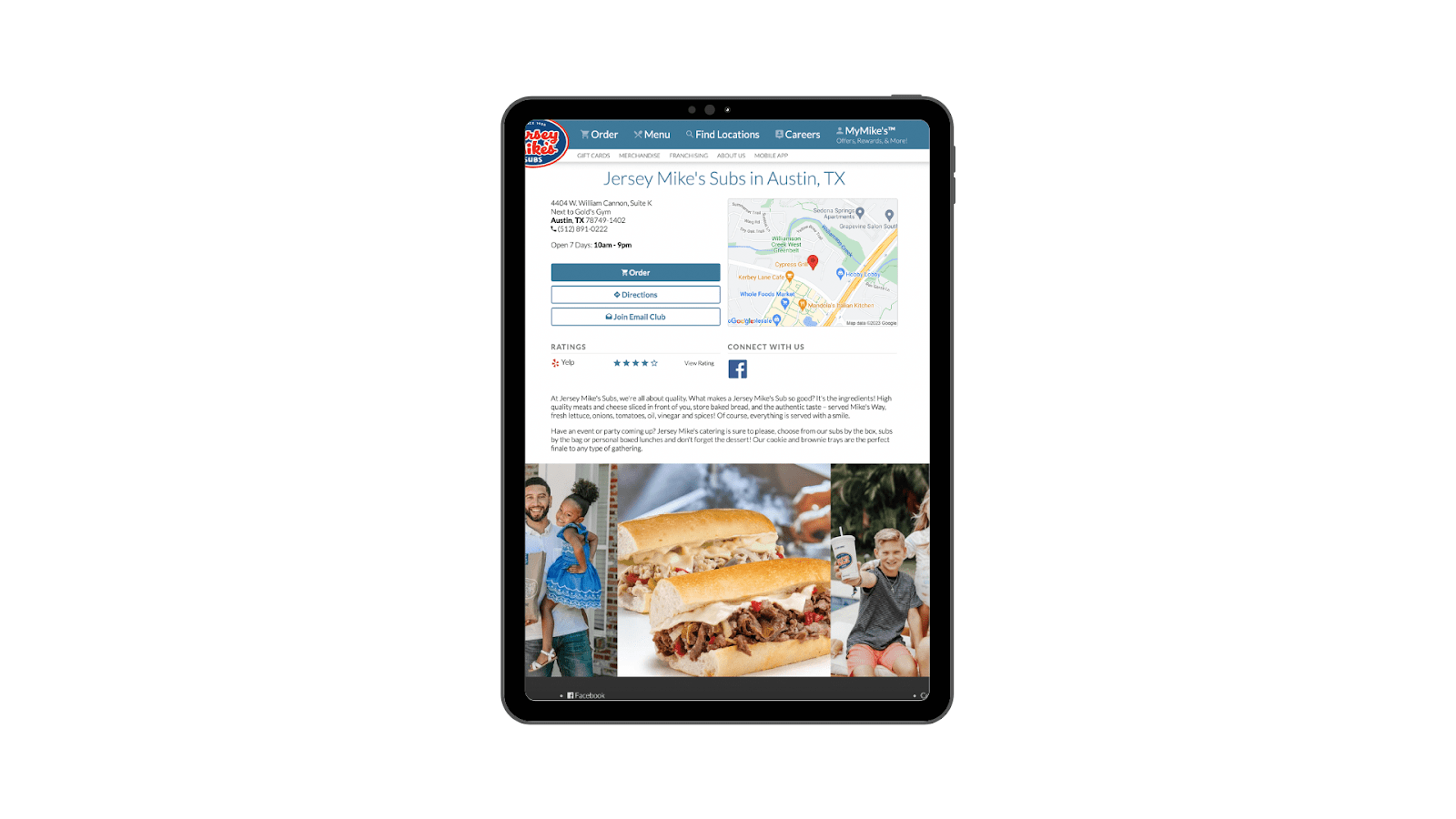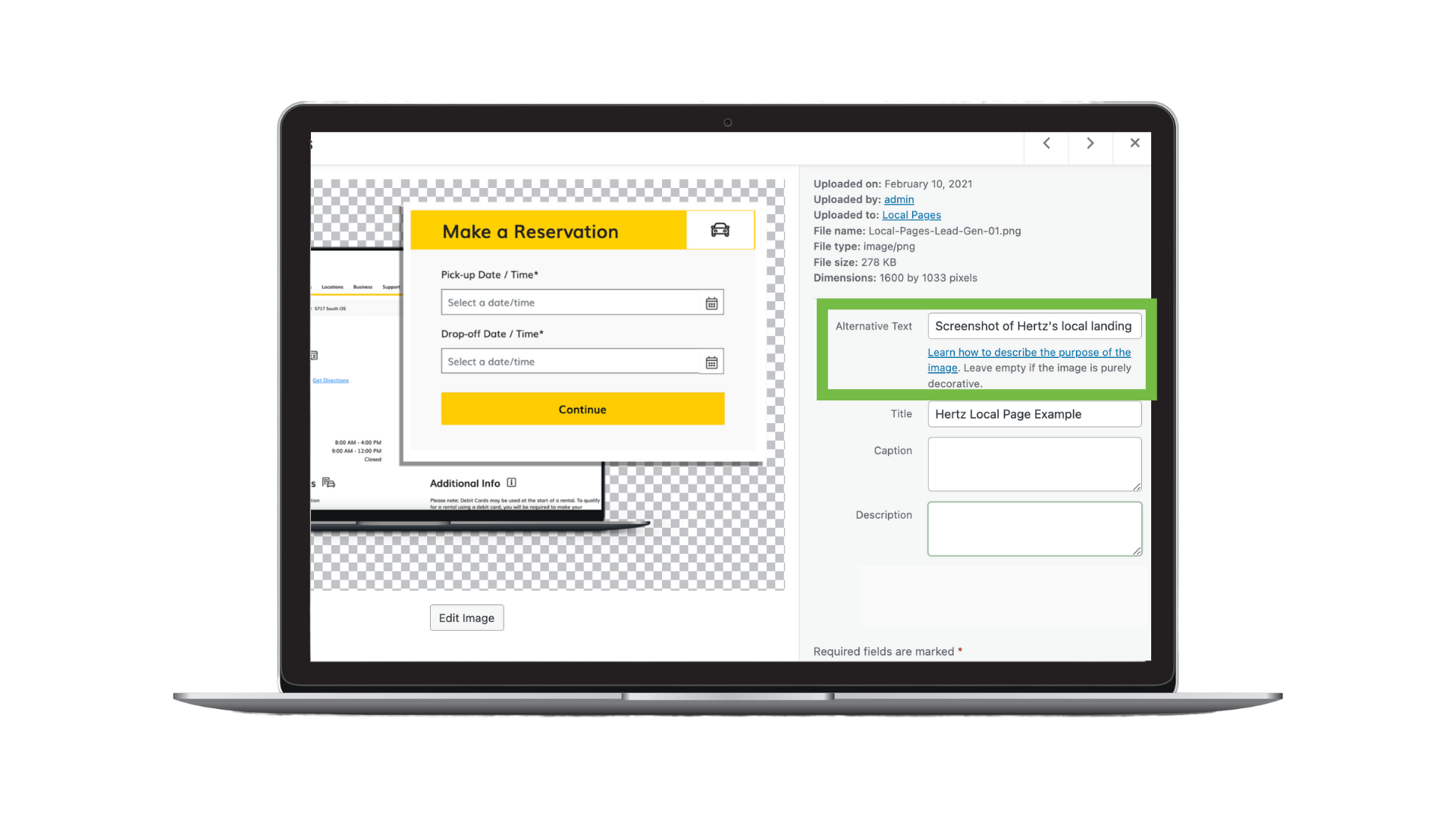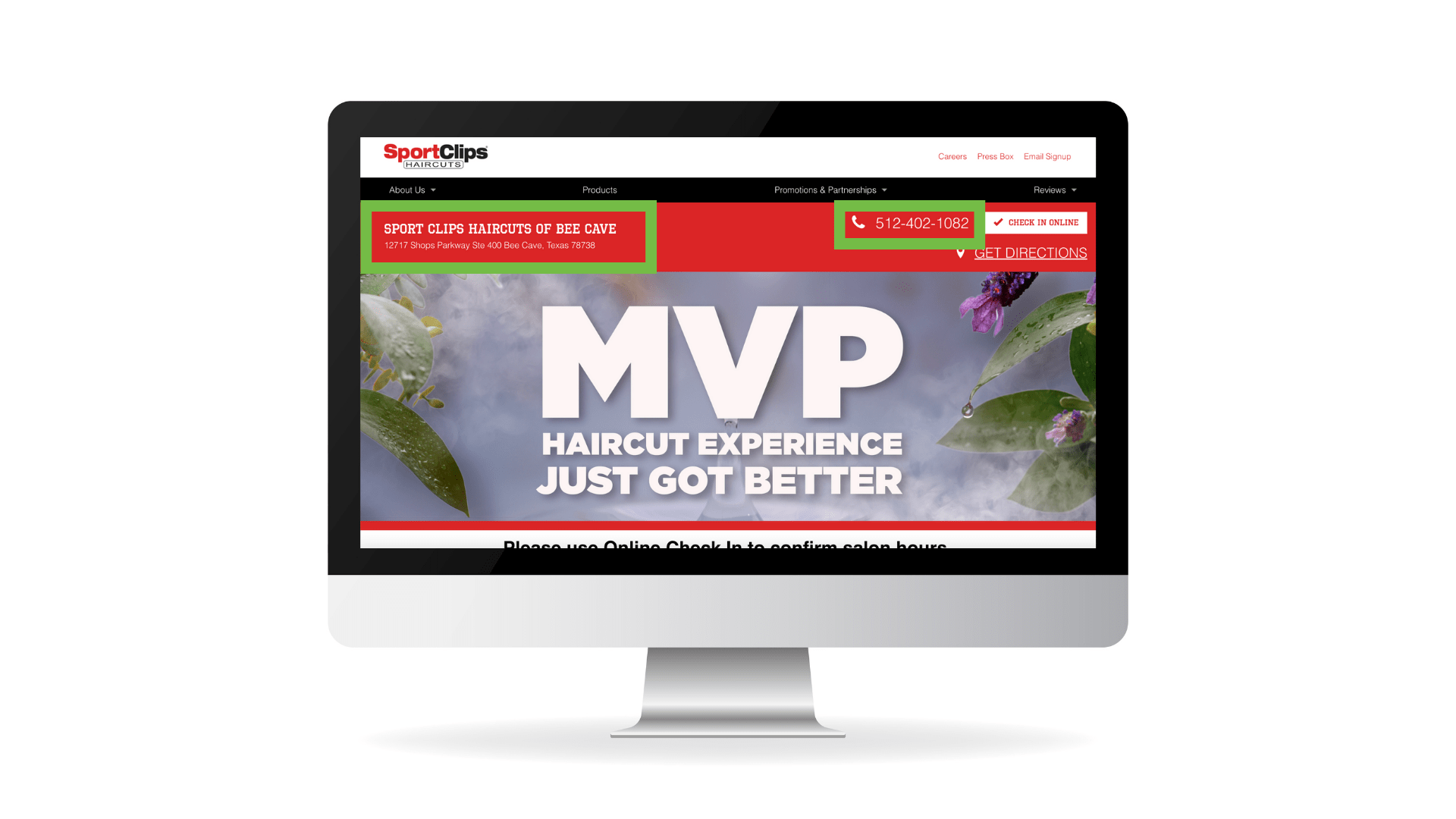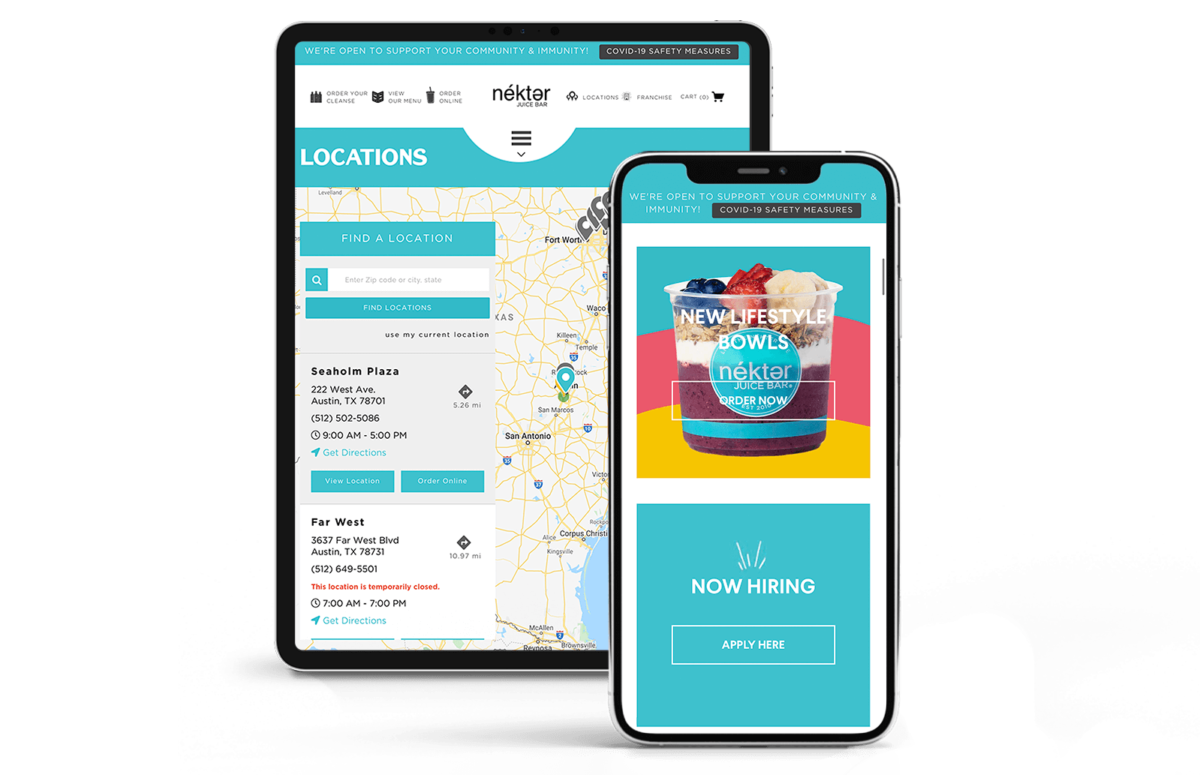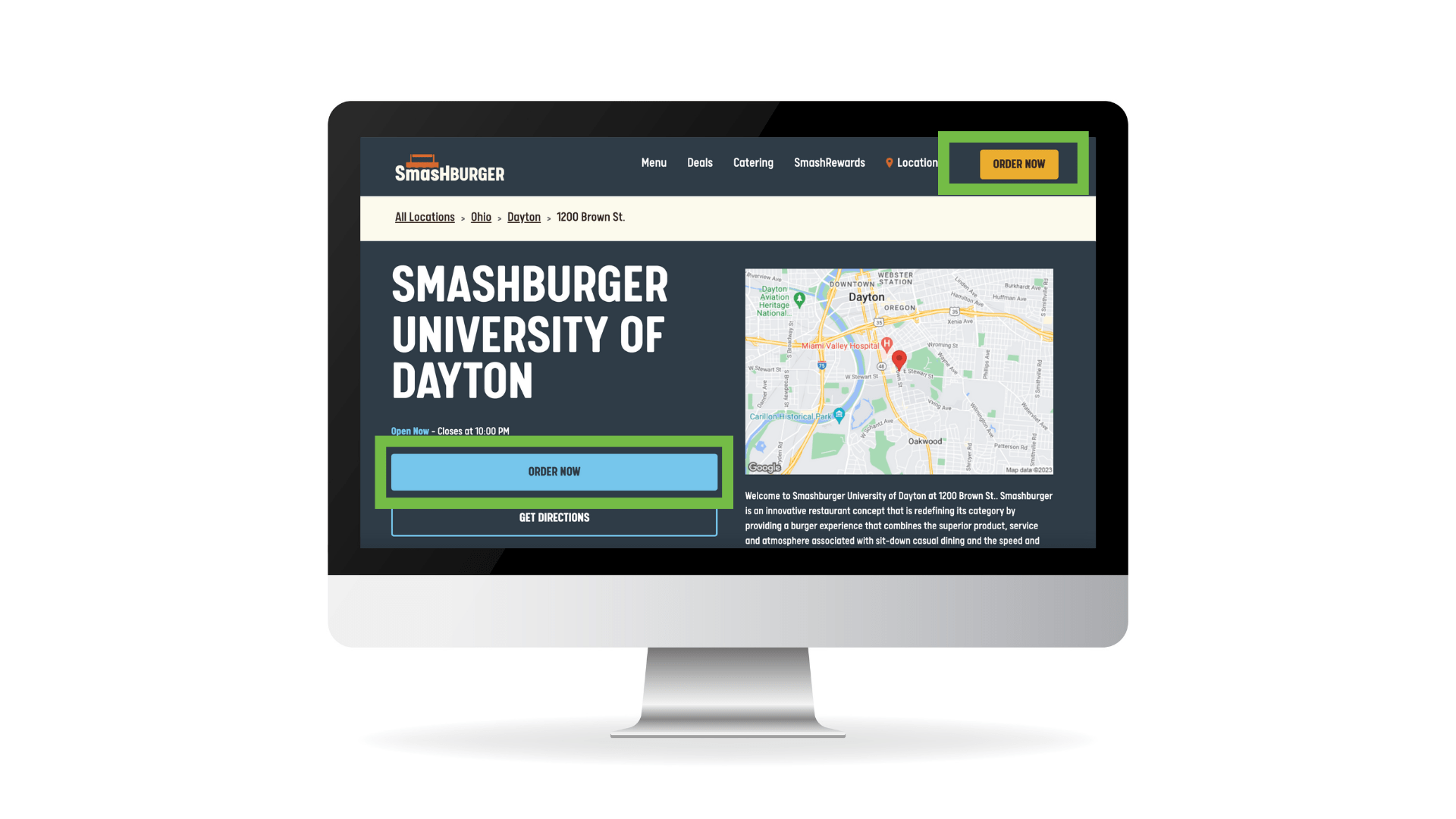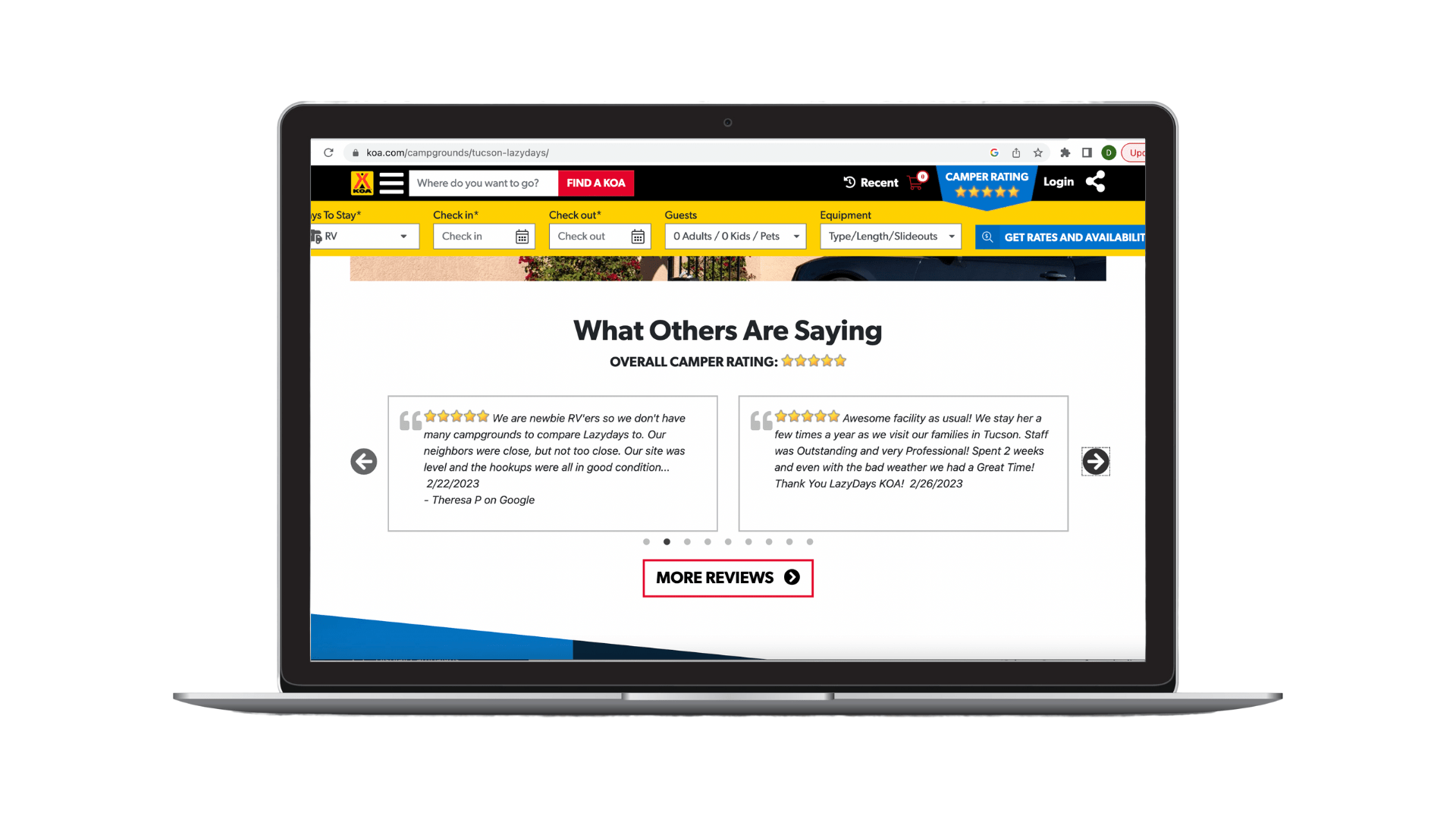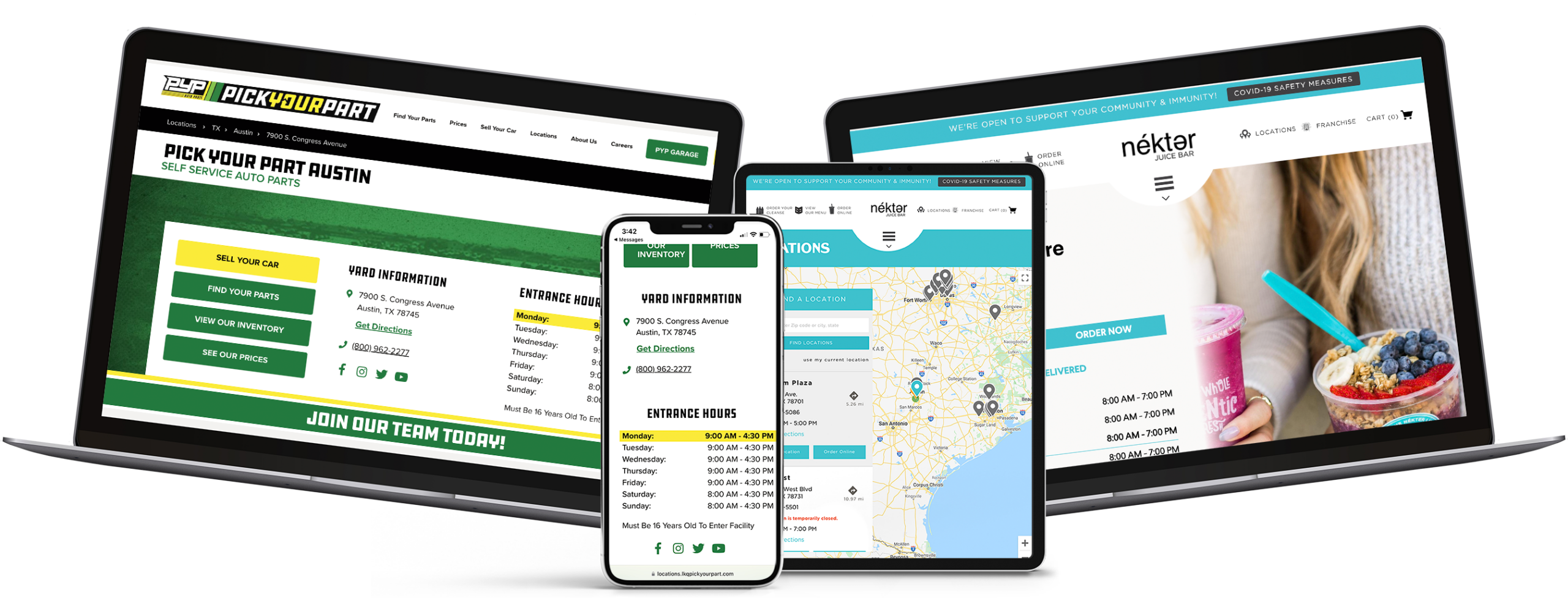How to Create Killer Local Landing Pages That Rank Well
Table of Contents
Consumers are searching locally for businesses. There are 800 million searches per month that contain some variation of “near me.” That’s why local and multi-location businesses must have local landing pages.
Creating effective local landing pages may seem daunting — especially if you have multiple locations, but we can help!
In this blog, we’ll discuss what local landing pages are and the importance of creating them for businesses with multiple locations. We will also explain how to create these pages effectively.
What Are Local Landing Pages?
Local landing pages, or local pages for short, are individual web pages built for a specific business location or franchise. They’re designed to target local consumers and provide people with pertinent information they’re searching for.
A well-optimized landing page will help improve your business’s local SEO rankings and digital traffic to a store location, resulting in more in-person visits or online purchases.
Below is an example of a Nékter Juice Bar’s local landing page in Vancouver, Washington.
A Look Into Local Landing Pages
As mentioned, a local landing page is an individual web page for a specific business location or franchise. A well-optimized landing page will improve local SEO and digital traffic to a store location, which results in more in-person visits.
Below is an example of a Nékter Juice Bar’s local landing page in Vancouver, Washington. The local page features its name, address, phone number (NAP), hours of operation, and a map of its location, which helps prospective customers find and purchase from this local store.
The Top 5 Benefits of Local Landing Pages
Now that you understand what local landing pages are, let’s dive into how they benefit your business.
1. Improved Local SEO
Improving your business’s local search engine optimization (SEO) is one of the main reasons to create local landing pages. Local landing pages are crucial because they help your business appear at the top of search results when people use relevant keywords to look for local services related to your business.
Furthermore, a top-performing local page linked to your Google Business Profile (GBP) helps you rank even higher in Google Search and Maps.
For more tips on improving your local SEO, download our Top 10 Things You Should Be Doing in Local SEO NOW Guide!
2. A Space for Location-Specific Content
Each business location or franchise is different. Local landing pages provide an excellent opportunity to showcase details unique to each location. Here are a few ways you can customize your local landing pages based on their location:
- Introduce your staff members
- Highlight your services
- Showcase online reviews
- Specify the area your local business covers
3. More Lead Generation
Local pages can boost lead generation through the inclusion of contact forms, appointment schedulers, quote requests, and click-to-call buttons to turn visitors into customers.
4. Better Online Reputation
Consumers place a high value on reviews. Reviews are sources of information that help people decide who to do business with. You can give potential consumers honest feedback about your business by placing reviews on your local pages. You’re also providing Google with user-generated content (UGC) that can help your pages rank higher.
5. Improved Customer Experience
Adding a list of the services you provide and CTAs on your local pages can boost conversions and make it much easier for customers to do business with you.
For instance, if you’re a restaurant brand, your services might include food ordering and delivery platforms like Uber Eats or GrubHub on your local pages. Similarly, a fitness center could include CTAs to view class schedules or book individual training appointments.
Now that you’ve learned some of the benefits of local landing pages let’s dive into how you can further optimize them for people and search engines.
13 Ways to Optimize Your Local Landing Pages
While creating local landing pages for each business location might feel overwhelming, you can use the recommendations in this section as a checklist. Once you create one optimized local landing page, it’ll be easier to create others.
1. Incorporate Keywords in Title Tags
Title tags are critical if you want search engines to understand what is on your local pages. A title tag is an HTML element that identifies the title of a webpage. Title tags tell Google and other search engines who, where, and what you do.
Below is an image of what title tags look like on Google’s search engine results page (SERP).
For local landing page title tags, include your business name, location, and a targeted keyword that explains what you do. Here’s an example of a well-written title tag: Giuseppe’s |Deep dish pizza in Anaheim
Lastly, know that space is limited. Google indexes the first 50 to 60 characters of a title tag. So, try to keep them under that character limit.
Action item: Consider what your customers are searching for to find your business, whether it’s “In-home caregiving services in LA county” or “Healthy vegan and vegetarian cafe in Orange, CA.” Write your landing page title tag to reflect user intent.
2. Review Meta Descriptions
Similar to title tags, meta descriptions can help your SEO efforts. Meta descriptions appear below title tags on search engines. Think of a meta description as a 50-160 character hook to entice the reader to visit your local landing page.
In your local pages’ meta descriptions, you can address your location, services, offerings, and how you differ from competitors near you or share information about the content the user is about to read.
3. Include Images
Images help search engines and users visualize your local business’s products or services better. High-quality images can boost your local pages’ SERP ranking.
Below, you’ll find an example of a Jersey Mike’s Subs local landing pages, which includes high-quality photos.
Action item: Confirm that all images uploaded by local staff or corporate are high quality, branded, and location-specific.
4. Write Alt Text or Tags for Images
Speaking of images, you should apply “alt” text or tags to all images on your local landing pages. Alt text provides text descriptions that help visually impaired users and search engines understand the content of your images.
You’ll typically enter alt text through your content management system like WordPress. Optimized alt text should describe the image accurately and, if relevant, should include keywords you’re trying to rank for.
Action item: Add relevant alt text to all images on your local pages.
5. Fix URL Structure
Landing page URLs that are long and confusing can lower your local landing pages’ rankings. It’s best practice to have clean URLs that use natural language and are relatively easy for humans to read.
Well-written URLs:
- Ensure that all of your URLs meet Google’s usability standards.
- Provide a better user experience (UX) for your customers by giving them an idea of what content they can expect from your page.
Local landing page URLs should not contain:
- The text “index.html,” once standard on home pages
- Unreadable and long ID numbers
- Uppercase letters
- Underscores
Action items:
- Check through your location pages to confirm that all URLs are clean.
- Note the ones that need to be changed or edited.
- If necessary, modify your URL templates to ensure all URLs are readable.
Action item: Double-check to ensure all locations’ addresses, phone numbers, and store hours are current. You don’t want to give your consumers or search engines the wrong information!
7. Add Schema Markup
Schema markup, or “structured data,” is code that helps search engines understand and display the content on your pages. Think of schema markup as a way to signal or validate to search engines the type of business you are and what the information on each page represents. It’s often inserted via HTML code.
For instance, a telephone number would need the schema markup “telephone” to signify to search engines you’re displaying your local business’s phone number.
At a minimum, you want to include Google’s “Local Business” markup on your local landing pages. Google’s Structured Data Markup Helper tool is a great entry point if you’re new to schema markup and want to know where to add it.
Action item: Add the “Local Business” schema markup to your local landing pages to help provide search engines with structured information about your business.
8. Be Mobile Friendly
Fifty-seven percent of users say they won’t recommend a business with a poorly designed mobile site. Google’s “mobile-first” index may already be treating the mobile version of your site as the primary version for search indexing purposes.
For these reasons, you should optimize your local landing pages for mobile devices. You want your landing pages to be responsive and fast-loading on mobile devices. We recommend testing your pages on iOS and Android phones, and make any necessary changes to improve the user experience (UX).
These are a few UX improvements you can check for:
- The text should be large and easily readable
- Page content should format itself neatly within the confines of the phone screen
- Navigation tools should conform to the needs of mobile users
Action item: Run your website through Google’s Mobile-Friendly Test page.
9. Ensure a Fast Loading Time
As mentioned in the previous section, fast load times are an essential part of SEO. Think about it — consumers are used to having everything they want instantly and will go elsewhere if your website takes too long to load on mobile or desktop devices.
Your local landing pages must load quickly. You can improve page speed by compressing images, caching your web pages, and reducing redirects.
Action Item: Google’s page speed test provides a good indicator of the overall speed of your site. Check your speed and review the recommendations for improvement.
10. List Product and Service Features
When users come across your local landing page, they’re likely considering a product or service you offer. Make it easy on users and turn them into customers by clearly describing your products and/or services.
You’ll also want to differentiate your local business from nearby competitors. You can do this by inserting keywords into your product descriptions to help make them stand out.
For instance, if you’re a furniture store, you might title a product “Blue Upholstered Sectional Sofa.” The more details you include, the easier it is for consumers to find what they want.
Action item: Track your most popular products or services across your stores and begin to highlight different ones across your landing pages.
11. Strategically Place CTAs
In addition to listing your product and service offerings, you should include clear calls to action (CTAs). Start converting online visitors with a CTA like an “order now” or “call today” button. Smashburger does this well, including a CTA to “order now” on one of its local landing pages twice.
Tracking your local pages’ CTAs is crucial to knowing which products or services sell best. You can also test how different types of CTAs perform. For instance, test whether a green versus a red button gets more clicks.
Action item: Set up ways to analyze and track your local pages’ CTAs, and try A/B testing different CTAs.
12. Include User-Generated Content + Reviews
User-generated content (UGC), such as reviews or customer testimonials, can help your local pages stick out to consumers. Ratings and reviews have become one of the top factors for consumers when determining which company to do business with.
The data speaks for itself. You should embed positive customer reviews from sites like Google or Yelp and social media platforms like Facebook onto your local pages. The example below showcases how to publish reviews on your local landing pages to help build consumer trust.
Action items:
- Create a system where customers can quickly leave reviews after visiting one of your brand’s local listings.
- Update your local pages with the most positive reviews from the previous month or quarter.
- See how SOCi Reviews can help.
13. Incorporate Internal Links
Internal links are links from your local landing pages that link to other pages on your company’s site. These might be links to products, blog posts, or other areas of your marketing team’s online demand-generation strategy.
Users and search engines find internal links helpful, and if done correctly, they will help increase your local page’s visibility.
Action item: Create an internal link strategy based on the information new and current customers are asking for and your most popular articles or posts about your products and services.
Recapping Local Landing Pages and Optimization
Now that you have a firm grasp of local SEO basics, it’s time to optimize your local landing pages! Before you begin, consider what information you want your local landing pages to display and how you’ll measure their success.
Also, don’t forget that you should always be writing for your target audience. What kind of information appeals to your ideal customer? What information do they find exciting and valuable? Depending on your industry, there may be different products, services, features, and other content you’ll want to showcase on your landing pages.
How SOCi Can Help You Create Local Landing Pages
While managing local landing pages across all your business locations might seem challenging, SOCi is here to help!
SOCi Local Pages allows your multi-location business to control 100s or 1,000s of customized, responsive local pages or sites that deliver a consistent brand presence and improve local search visibility.
Branded local pages are fully responsive on any device and are built to meet your unique business needs. Select multiple template options that you can customize with banners, image galleries, products, social feeds, and more.
Best of all, SOCi can help deploy branded local pages in less than two weeks. You can also make real-time updates to local pages and website data in just a few minutes. Elevate your local landing pages, increase conversions, and win local customers with SOCi Local Pages.
For more information on SOCi Local Pages and how SOCi can help your multi-location business dominate the rest of its localized marketing efforts, request a demo today!
